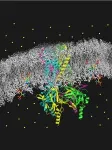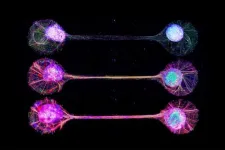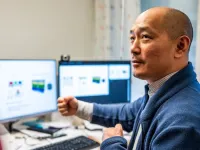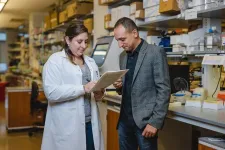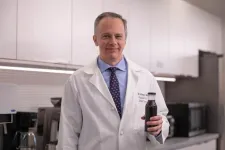(Press-News.org) Chasing ever-higher qubit counts in near-term quantum computers constantly demands new feats of engineering.
Among the troublesome hurdles of this scaling-up race is refining how qubits are measured. Devices called parametric amplifiers are traditionally used to do these measurements. But as the name suggests, the device amplifies weak signals picked up from the qubits to conduct the readout, which causes unwanted noise and can lead to decoherence of the qubits if not protected by additional large components. More importantly, the bulky size of the amplification chain becomes technically challenging to work around as qubit counts increase in size-limited refrigerators.
Cue the Aalto University research group Quantum Computing and Devices (QCD). They have a hefty track record of showing how thermal bolometers can be used as ultrasensitive detectors, and they just demonstrated in an April 10 Nature Electronics paper that bolometer measurements can be accurate enough for single-shot qubit readout.
A new method of measuring
To the chagrin of many physicists, the Heisenberg uncertainty principle determines that one cannot simultaneously know a signal’s position and momentum, or voltage and current, with accuracy. So it goes with qubit measurements conducted with parametric voltage-current amplifiers. But bolometric energy sensing is a fundamentally different kind of measurement—serving as a means of evading Heisenberg’s infamous rule. Since a bolometer measures power, or photon number, it is not bound to add quantum noise stemming from the Heisenberg uncertainty principle in the way that parametric amplifiers are.
Unlike amplifiers, bolometers very subtly sense microwave photons emitted from the qubit via a minimally invasive detection interface. This form factor is roughly 100 times smaller than its amplifier counterpart, making it extremely attractive as a measurement device.
‘When thinking of a quantum-supreme future, it is easy to imagine high qubit counts in the thousands or even millions could be commonplace. A careful evaluation of the footprint of each component is absolutely necessary for this massive scale-up. We have shown in the Nature Electronics paper that our nanobolometers could seriously be considered as an alternative to conventional amplifiers. In our very first experiments, we found these bolometers accurate enough for single-shot readout, free of added quantum noise, and they consume 10 000 times less power than the typical amplifiers—all in a tiny bolometer, the temperature-sensitive part of which can fit inside of a single bacterium,’ says Aalto University Professor Mikko Möttönen, who heads the QCD research group.
Single-shot fidelity is an important metric physicists use to determine how accurately a device can detect a qubit’s state in just one measurement as opposed to an average of multiple measurements. In the case of the QCD group’s experiments, they were able to obtain a single-shot fidelity of 61.8% with a readout duration of roughly 14 microseconds. When correcting for the qubit’s energy relaxation time, the fidelity jumps up to 92.7%.
‘With minor modifications, we could expect to see bolometers approaching the desired 99.9% single-shot fidelity in 200 nanoseconds. For example, we can swap the bolometer material from metal to graphene, which has a lower heat capacity and can detect very small changes in its energy quickly. And by removing other unnecessary components between the bolometer and the chip itself, we can not only make even greater improvements on the readout fidelity, but we can achieve a smaller and simpler measurement device that makes scaling-up to higher qubit counts more feasible,’ says András Gunyhó, the first author on the paper and a doctoral researcher in the QCD group.
Prior to demonstrating the high single-shot readout fidelity of bolometers in their most recent paper, the QCD research group first showed that bolometers can be used for ultrasensitive, real-time microwave measurements in 2019. They then published in 2020 a paper in Nature showing how bolometers made of graphene can shorten readout times to well below a microsecond.
The work was carried out in the Research Council of Finland Centre of Excellence for Quantum Technology (QTF) using OtaNano research infrastructure in collaboration with VTT Technical Research Centre of Finland and IQM Quantum Computers. It was primarily funded by the European Research Council Advanced Grant ConceptQ and the Future Makers Program of the Jane and Aatos Erkko Foundation and the Technology Industries of Finland Centennial Foundation.
Full paper:
András M. Gunyhó, Suman Kundu, Jian Ma, Wei Liu, Sakari Niemelä, Giacomo Catto, Vasilii Vadimov, Visa Vesterinen, Priyank Singh, Qiming Chen, Mikko Möttönen, Single-Shot Readout of a Superconducting Qubit Using a Thermal Detector, Nature Electronics, https://doi.org/10.1038/s41928-024-01147-7 (2024).
Contact information:
Mikko Möttönen
Professor, QCD group leader
Aalto University
mikko.mottonen@aalto.fi
m. +358505940950
András Gunyhó
Doctoral researcher
Aalto University
andras.gunyho@aalto.fi
END
New method of measuring qubits promises ease of scalability in a microscopic package
Aalto University researchers are the first in the world to measure qubits with ultrasensitive thermal detectors—thus evading the Heisenberg uncertainty principle
2024-04-10
ELSE PRESS RELEASES FROM THIS DATE:
Study shedding new light on Earth’s global carbon cycle could help assess liveability of other planets
2024-04-10
Research has uncovered important new insights into the evolution of oxygen, carbon, and other vital elements over the entire history of Earth – and it could help assess which other planets can develop life, ranging from plants to animals and humans.
The study, published today in Nature Geoscience and led by a researcher at the University of Bristol, reveals for the first time how the build up of carbon-rich rocks has accelerated oxygen production and its release into the atmosphere. Until now the exact nature of how the atmosphere became oxygen-rich has long eluded scientists and generated conflicting explanations.
As carbon dioxide is steadily ...
Connecting lab-grown brain cells provides insight into how our own brains work
2024-04-10
Tokyo, Japan – The idea of growing a functioning human brain-like tissues in a dish has always sounded pretty far-fetched, even to researchers in the field. Towards the future goal, a Japanese and French research team has developed a technique for connecting lab-grown brain-mimicking tissue in a way that resembles circuits in our brain.
It is challenging to study exact mechanisms of the brain development and functions. Animal studies are limited by differences between species in brain structure and function, and brain cells grown in the lab tend to lack the characteristic ...
Breakthrough for next-generation digital displays
2024-04-10
Researchers at Linköping University, Sweden, have developed a digital display screen where the LEDs themselves react to touch, light, fingerprints and the user’s pulse, among other things. Their results, published in Nature Electronics, could be the start of a whole new generation of displays for phones, computers and tablets.
“We’ve now shown that our design principle works. Our results show that there is great potential for a new generation of digital displays where new advanced ...
Wistar scientists identify pro-aging ‘sugar signature’ in the blood of people living with HIV
2024-04-10
PHILADELPHIA — (April 10, 2024) — The Wistar Institute’s associate professor Mohamed Abdel-Mohsen, Ph.D., along with his team and collaborators, has identified sugar abnormalities in the blood that may promote biological aging and inflammation in people living with HIV (PLWH). The findings, taken from a large data study comprising more than 1200 participants, are detailed in the new paper, “Immunoglobulin G N-glycan Markers of Accelerated Biological Aging During Chronic HIV Infection,” published in the journal Nature Communications.
Despite advances ...
CAMH develops first ever clinically validated natural supplement to prevent postpartum blues
2024-04-10
A new study published in the Lancet discovery science journal eClinicalMedicine has confirmed that a novel natural supplement—invented, researched, developed and commercialized at the Centre for Addiction and Mental Health (CAMH)—prevents postpartum blues, and reduces symptoms of postpartum depression over the following six months after giving birth.
Up to 8 out of ten new mothers experience postpartum, or ‘baby,’ blues, characterized by mood swings, crying spells, anxiety and difficulty sleeping. The condition usually begins within the first few days after delivery and may last for up to two weeks. Postpartum ...
Breakthroughs in durable mechanical circulatory support (MCS) devices add years to lives and life to years for heart failure patients
2024-04-10
Embargoed until 10:00 a.m. Wednesday, 10 April, 2024 Central European Summer Time (GMT +2)
10 April, 2024, Prague, Czech Republic—The same technology that enables a bullet train to travel at speeds up to 200 mph without touching its rails now keeps a failing heart pumping—and in the near future, it will do so via a wireless power connection. Mandeep R. Mehra, MD, FRCP described the cutting-edge heart pump and other advances in mechanical circulatory support (MCS) today at the Annual Meeting and Scientific Sessions of the International Society for Heart and Lung Transplantation (ISHLT) in ...
AI will provide heart transplant surgeons with new decision-making data
2024-04-10
Embargoed until 10:00 a.m., Wednesday, 10 April, 2024 Central European Summer Time (GMT +2)
10 April 2024, Prague, Czech Republic—Artificial intelligence will significantly impact the heart transplantation process by helping physicians better assess the complex factors impacting patient outcomes, according to researchers at today’s Annual Meeting and Scientific Sessions of the International Society of Heart and Lung Transplantation (ISHLT) in Prague.
“Until now, we’ve assessed the likelihood of transplant success based on individual risk factors,” said Eileen Hsich, medical director of the Heart Transplant Program at the Cleveland ...
Novel UV broadband spectrometer revolutionizes air pollutant analysis
2024-04-10
Sunlight has a major influence on chemical processes. Its high-energy UV radiation in particular is strongly absorbed by all materials and triggers photochemical reactions of the substances present in the air. A well-known example is the formation of ground-level ozone when UV light hits nitrogen oxides. A research team led by Birgitta Schultze-Bernhardt from the Institute of Experimental Physics at Graz University of Technology (TU Graz) is now utilising this high reaction potential for a new method of environmental monitoring. ...
Kyiv’s Heart Institute keeps transplanting hearts despite war
2024-04-10
Embargoed until 8:30 a.m. Wednesday, 10 April, 2024, Central European Summer Time
10 April, 2024, Prague, Czech Republic—Amid the persistent threat of missiles from the air and an array of hazardous terrestrial obstacles, the Heart Institute of the Ministry of Health in Kyiv has continued to provide heart transplants to Ukraine’s citizens, performing 40 of the life-saving procedures since Russia’s full-scale invasion of the country in 2022. The Heart Institute’s Director Borys Todurov, MD, PhD, reported on his team’s extraordinary efforts today at the Annual Meeting and Scientific Sessions of the International Society for Heart and Lung Transplantation ...
Can artificial intelligence techniques help clinicians assess and treat patients with bone fractures?
2024-04-10
Investigators have applied artificial intelligence techniques to gait analyses and medical records data to provide insights about individuals with leg fractures and aspects of their recovery.
The study, which is published in the Journal of Orthopaedic Research, uncovered a significant association between the rates of hospital readmission after fracture surgery and the presence of underlying medical conditions. Correlations were also found between underlying medical conditions and orthopedic complications, although these links were not significant.
It was also ...
LAST 30 PRESS RELEASES:
Scalable and healable gradient textiles for multi‑scenario radiative cooling via bicomponent blow spinning
Research shows informed traders never let a good climate crisis go to waste
Intelligent XGBoost framework enhances asphalt pavement skid resistance assessment
Dual-function biomaterials for postoperative osteosarcoma: Tumor suppression and bone regeneration
New framework reveals where transport emissions concentrate in Singapore
NTP-enhanced lattice oxygen activation in Ce-Co catalysts for low-temperature soot combustion
Synergistic interface engineering in Cu-Zn-Ce catalysts for efficient CO2 hydrogenation to methanol
COVID-19 leaves a lasting mark on the human brain
Scientists use ultrasound to soften and treat cancer tumors without damaging healthy tissue
Community swimming program for Black youth boosts skills, sense of belonging, study finds
Specific depressive symptoms in midlife linked to increased dementia risk
An ‘illuminating’ design sheds light on cholesterol
Who is more likely to get long COVID?
Study showcases resilience and rapid growth of “living rocks”
Naval Research Lab diver earns Office of Naval Research 2025 Sailor of the Year
New Mayo-led study establishes practical definition for rapidly progressive dementia
Fossil fuel industry’s “climate false solutions” reinforce its power and aggravate environmental injustice
Researchers reveal bias in a widely used measure of algorithm performance
Alcohol causes cancer. A study from IOCB Prague confirms damage to DNA and shows how cells defend against it
Hidden viruses in wastewater treatment may shape public health risks, study finds
Unlock the power of nature: how biomass can transform climate mitigation
Biochar reshapes hidden soil microbes that capture carbon dioxide in farmland
Reducing saturated fat intake shows mortality benefit, but only in high-risk individuals
Manta rays create mobile ecosystems, study finds
Study: Mixed results in using lipoic acid to treat progressive multiple sclerosis
Norbert Holtkamp appointed director of Fermi National Accelerator Laboratory
New agentic AI platform accelerates advanced optics design
Biologists discover neurons use physical signals — not electricity — to stabilize communication
Researchers discover that a hormone can access the brain by hitchhiking
University of Oklahoma researcher awarded funding to pursue AI-powered material design
[Press-News.org] New method of measuring qubits promises ease of scalability in a microscopic packageAalto University researchers are the first in the world to measure qubits with ultrasensitive thermal detectors—thus evading the Heisenberg uncertainty principle


